Issue 5, March/April 2006
Even though our March meeting fell during the week of the Artic Games, the turnout was excellent. We had over fifty in attendance.
Our program for the March meeting was focused on inoculating logs with mycelium (in the form of wooden plugs) in anticipation of growing our own mushrooms. We had purchased 900 plugs from Fungi Perfecti, 300 each of three species (a Pleurotus and a Hericium which favored hardwoods and one Hericium that preferred conifers). A number of folks brought drills, bits, cottonwood and spruce logs and the canning wax that was used to seal the holes and cut ends of the logs.
We began our meeting with Janice Chumley giving the financial report and brief explanation of the inoculation process. She then turned the meeting over to Dan Brady and Linda Stubbert (two club members with a considerable amount of experience growing mushrooms), and they were gracious enough to share some of their wisdom and knowledge with us. Then, it was out to the parking lot to drill and plug our log! It was a great time and a wonderful opportunity to get better acquainted.
Several folks snapped photos and sent them my way. I couldn’t include all of them in the newsletter, but I have inserted a few that were taken by Cliff Cullings. I have started a ‘club photos file’ in my computer. If we can figure out a way to do it, I would like to start an ‘online’ photo album so all can enjoy them.
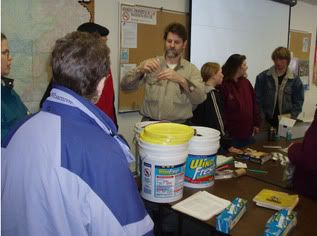
Dan has an infectious enthusiasm when it comes to growing mushrooms! There is a lot to be learned from both him and Linda, and we are privileged to have them among our membership.
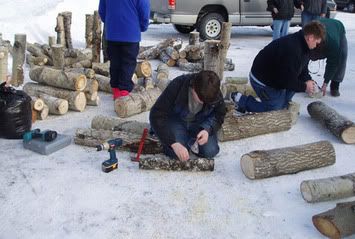
Step #1, drill those holes. ( Cottonwood logs and cordless drills.)
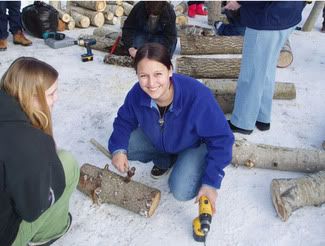
Step #2, driving in the plugs. (We had folks from 8 to 80 out in the parking lot that afternoon. It is great to see young people show an interest in a hobby that will bring them a great deal of enjoyment throughout their life.)
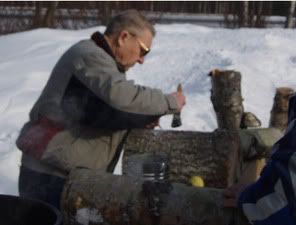
Step #3, sealing the log. (This gives our mycelium a fighting chance to colonize the log before some other fungus sets up housekeeping!)
For those who did not get the handout on caring for your inoculated log that Janice prepared, I have included it here:
- Cut logs 3 weeks to 3 months before use (late winter or early spring is best).
Plugging logs in the spring is best (above freezing temperatures are needed).
Keep newly plugged logs in a garage, root cellar, shed, etc. so they do not freeze.
Drill 5/16” holes, 2” deep and preferably not more than 4” apart (evenly spaced in diamond pattern).
Insert 1 plug per hole, drive it in with a hammer and seal the hole with wax to protect the mycelium while it is growing.
Painting the ends with wax will also help the log to retain moisture.
Keep the log out of direct sun-light. Water the log once or twice a week. Do not cover the log with plastic as it will cause mold.
Wait patiently for your log to fruit. It can take as long as 6-12 months for the mycelium to colonize the wood.
In a few months (after the mycelium has had an opportunity to grow, we will be giving out additional information that will help you to get the most fruit from your log.
Again, be patient! You will not see any outward change in your log until it begins to fruit.
If you have questions or need more information than we can give you, the folks at Fungi Perfecti are willing to help. They have a hotline number – (360) 426-9292 (8:30 am – 4:30 pm Pacific Time, Monday thru Friday) or you can get technical support on the internet at mycomedia@aol.com. You might also want to visit their web site at www.fungi.com.
________________________
NAMA (North American Mycological Society) has a website-chat room where you can interact with others who are interested in growing mushrooms. They also have an online index of about 50 websites that can be accessed from their page. These are home and commercial suppliers, university sponsored sites and articles on mushroom cultivation. Just go to www.namyco.org/cultivation/index.html.
________________________
If anyone would like a copy of Paul Stamet’s book Growing Gourmet and Medicinal Mushrooms, we are able to purchase them for $22.50 (plus the cost of shipping). This is the definitive work on mushroom cultivation and is considered to be the mushroom cultivator’s bible. This book explains in detail the cultivation techniques and growing parameters for 31 different edible and medicinal species. It is a large book (592 pages) and has over 400 photos and diagrams. Normally, the book retails for $44.95. If there is enough interest, we will place an order.
________________________
The following recipe was submitted by one of the gals in the club. It came to me through another party, so I don’t know who to thank. But, it sounds like it would be well worth trying!
- 4 slices bacon (fried crisp)
3 cups sliced mushrooms (recipe
originally called for chanterelles)
½ cup chopped onions
1 – 10oz. can cream of mushroom soup
1 ¼ cups water
2 cups frozen hash browns
1 tsp celery salt
1 TBS Parsley
1 TBS Soy sauce
Mix all ingredients together, heat and serve.
We have ordered a video from NAMA for the April 1st meeting. Depending upon availability, we will either be viewing a program narrated by Dr. Michael Beug, Morels, Truffles And Other Spring Fungi or a presentation by Nancy Smith Weber, After The Ashes Cool: A Look At Post Fire Fungi.
For our first foray of the season we plan to go to one of the local burns from last summer. In light of that, either of these films should be helpful.
Most people think only morels fruit in the burned areas. But, there are actually many species that thrive after a fire. Peziza’s are common. So are numerous Pholiota species, especially Pholiota carbonaria. Lyophyllum species are frequently encountered around the perimeter of burns where the soil has been disturbed by fire breaks etc. Coprinus comatus often occurs in abundance for several years following a fire. A variety of Helvellas and Gyromitras are common and there is always a myriad of LBMs.
________________________
In an effort to include something instructional in every newsletter, here is a brief explanation of the methodology and the importance of using scientific nomenclature.
Every species has a unique two word name called a Binomial. In this binomial, the first word is the generic name. This name places the organism in a genus: a collection of similar and/or related species. The second is the species name. This name is unique to only one species in the genus. The name of the species consists of both names, because only the two-word combination is unique to a single species.
For example, among West Coast mushrooms, there are five species that share the species name cascadensis. If we were given only the species name without being given the genus name, we could not be sure which particular mushroom species was being addressed. It could be Cortinarius cascadensis, Galerina cascadensis, Lactarius cascadensis, Psathyrella cascadensis or Russula cascadensis.
But, why use the binomial and not common English names? Common names differ from language to language, country to country and even place to place. Without the use of a common language and classification system, accurate identification would be impossible. (Latin was chosen because it is a dead (rather than evolving) language and to avoid any offence that might occur from having to use another person’s native tongue.)
Common names are often applied to unrelated organisms. The Australian, North American and English ‘robins’ are not only different species, but different genera. Common names can also be very misleading. Irish Moss is a red algae, Reindeer Moss is a lichen, Club Moss is a fern and Spanish Moss is a vascular plant.
Learning to call a species by its binomial name is not difficult. It is a discipline that you will find has far more benefits than drawbacks. No one will progress very far in their knowledge of fungi or their ability to communicate that knowledge without learning to use the binomials.
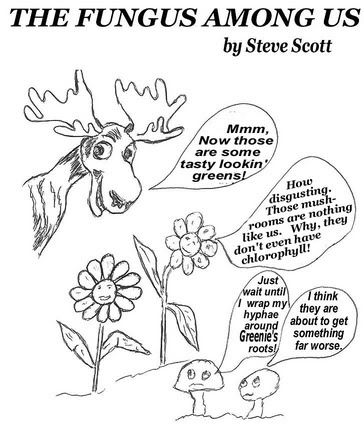
Our next meeting will be on April 1st, at 1:00 pm in the Cook Inlet Aquaculture Building, 40610 K-Beach Rd.
Don’t forget to check out the website at: http://kpms.blogspot.com.
Have a great month. We will see you April 1st,
Steve

0 Comments:
Post a Comment
<< Home